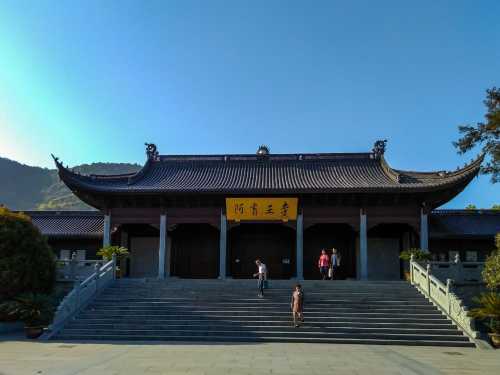App
Customer Support
NZD
Find Bookings
Popular Trip Moments
My First Choice for a Vacation: The Ningbo Hotel That Amazed Me — Jinmao Joy Hotel Ningbo | New Century Grand Hotel Ningbo | Check in all 337 cities in China. Stop 98: Ningbo, Zhejiang | First Time in Ningbo: The Perfect Itinerary | Ningbo Travel: An Aesthetic Hideaway by Dongqian Lake | Danshan Chishui: A Landscape of Red Elegance | Siming Mountain National Forest Park: A Nature Lover's Paradise | Siming Lake: A Serene Getaway | Xiaolu Creek: A Summer Paradise | Baiyun Bridge: A Timeless Arch of History | Wang Yangming’s Former Residence: A Monument of Legacy | Yuyao Celebrity Hall: A Free Peek into Local Legends | Yangming Park: A Scenic Stroll with a View | Longshan Park: A Harmony of Nature and History | Longquan Ancient Temple: Small, Serene, and Sacred | Ningbo: A Hidden Gem of Culture and Nature 🌸 | Exploring Spring in Ningbo: The Serene Beauty of Free-Entry Tiantong Temple | Nantang Old Street: A Charming Blend of History and Nighttime Beauty | Ningbo Museum: A Journey Through 6,000 Years of Culture | Hanling Old Street: A Snapshot of Jiangnan’s Charm | Dongqian Lake: A Legacy of 1,200 Years | Ashoka Temple: A Revered Sanctuary of Buddhist Heritage | Tiantong Temple: A Sanctuary of Zen and Splendor | Laowaitan: Where Heritage Meets the Glow of Night | Drum Tower: Ningbo's Timeless Landmark | Tianyi Pavilion: A Treasure Trove of Literary Heritage | Exploring "Ningbo's Little Rio" - Taolao Mountain: Ultimate Hiking Guide | Slow Living in a Seaside Town: Bask in the Sun in Qiangjiao, Ningbo's "Little Jeju" | Discover Hemu Village Houses | Weekend road trip~ A seaside hotel reachable within 1 hour from Ningbo!
Popular Travel Types
Recommended Attractions at Popular Destinations
Bangkok attraction near me | Manila attraction near me | Tokyo attraction near me | Taipei attraction near me | Hong Kong attraction near me | Seoul attraction near me | Kuala Lumpur attraction near me | Los Angeles attraction near me | Shanghai attraction near me | New York attraction near me | Shenzhen attraction near me | Osaka attraction near me | Singapore attraction near me | London attraction near me | Guangzhou attraction near me | San Francisco attraction near me | Beijing attraction near me | Macau attraction near me | Bali attraction near me | Jakarta attraction near me | Paris attraction near me | Ho Chi Minh City attraction near me | Istanbul attraction near me | Phuket attraction near me | Chicago attraction near me | Seattle attraction near me | Toronto attraction near me | Orlando attraction near me | Cebu attraction near me | Chiang Mai attraction near me
Popular Attractions
Shanghai Museum | Headstream Hot Spring | Seoul Sky | Ngong Ping 360 | Shenquan Ecological Tourist Attraction | Hong Kong Disneyland | Tianmen Mountain National Forest Park | Kiwi Park Queenstown | Aqua Luna | Blue Mountains National Park | Sydney Tower Eye | Shishi Sacred Heart Cathedral | Christchurch Botanic Gardens | Australian Outback Spectacular | Buddhist Grotto Quest | At The Top, Burj Khalifa | Tingmeng Haohua Youting Club | Dujiangyan China Giant Panda Garden (formerly known as Panda Paradise) | Te Vara Nui Village | Sai Baba Temple | Inderøen | JGM Bel Aire Golf Club | Murphy Memorial Library | Groot Beekermark (Bergherbos) | Die Woelbung der Haende | Sree Dhanwanthari Temple | Daizenin Temple | Raumanga Waterfall | Spring Water in Myoken Shrine | The Bund
Popular Restaurants in Ningbo
Seafood House | 余姚伯瑞特酒店·阳明轩 | 宁波香格里拉大酒店·香宫中餐厅 | Dongqianhuhuamaoxi'erdundujiajiudiandatangba | ZhUANGYUANLOU RESTAURANT | YANG MING WEN QUAN SHAN ZHUANG CAN TING | Ninghai Restaurant | Tie Ge Bi ( Yue Hu Sheng Yuan ) | A MAO RESTAURANT | Shan Kui Jia JinZhi Cuisine(1844 Xintiandi ) | MING COURT | 如辉奉化点心(天一店) | OLD NINGBO ALLEY RESTAURANT | FlavourCourtyard Restaurant | 甬上名灶(环城西路店) | 阿拉名灶·阿拉宁波人的味道(月湖店) | Yi Coffee Buffet | Ninghai Restaurant (guloufen) | 海味世家·本味餐厅(明州里店) | Ninghai Restaurant (simingzhonglu) | TOP POT TALE | COMMUNE(月湖盛园店) | Yong Shang Wai Po Qiao ( Universal Yin Tai Cheng ) | RIVERA | XINRONGJI | LELECHA乐乐茶(来福士广场店) | 客串出品(钱湖天地店) | Lake Shore Cafe | SAMOOMPAI | 老宁波1381餐厅(东岸里店)
Popular Ranked Lists
Popular Restaurants for Views & Experiences in Baja Sardinia | Popular Best Things to Do in Ziyuan | Top 17 Local Restaurants in Huzhou | Top 3 Best Things to Do in Dazhou | Top 10 Local Restaurants in Naha | Popular Luxury Hotels Near Taean-gun | Popular Best Things to Do in Dongxing | Top 20 Local Restaurants in Nanchang | Top 10 Local Restaurants in Honolulu | Top 10 Local Restaurants in Tehran | Popular Luxury Hotels Near Etretat | Top 19 Local Restaurants in Huai'an | Popular Premium Hotels Near Kinshasa | Popular Luxury Hotels Near Fort William | Top 10 Local Restaurants in Amman | Popular Best Things to Do in Yongshun | Popular Best Things to Do in Wen County | Popular Best Things to Do in Changsha County | Popular Best Things to Do in Boluo | Top 3 Best Things to Do in Ziyang | Top 5 Best Things to Do in Weinan | Popular Best Things to Do in Puge | Top 10 Local Restaurants in The Rocks | Popular Luxury Hotels Near Jezerce | Popular Luxury Hotels Near Wuppertal | Top 10 Local Restaurants in Phi Phi Islands | Popular Luxury Hotels in Fes | Top 16 Local Restaurants in Wenzhou | Top 3 Best Things to Do in Yuyao | Popular Luxury Hotels Near Anand
Payment Methods
Our Partners
Copyright © 2025 Trip.com Travel Singapore Pte. Ltd. All rights reserved
Site Operator: Trip.com Travel Singapore Pte. Ltd.
Site Operator: Trip.com Travel Singapore Pte. Ltd.
























